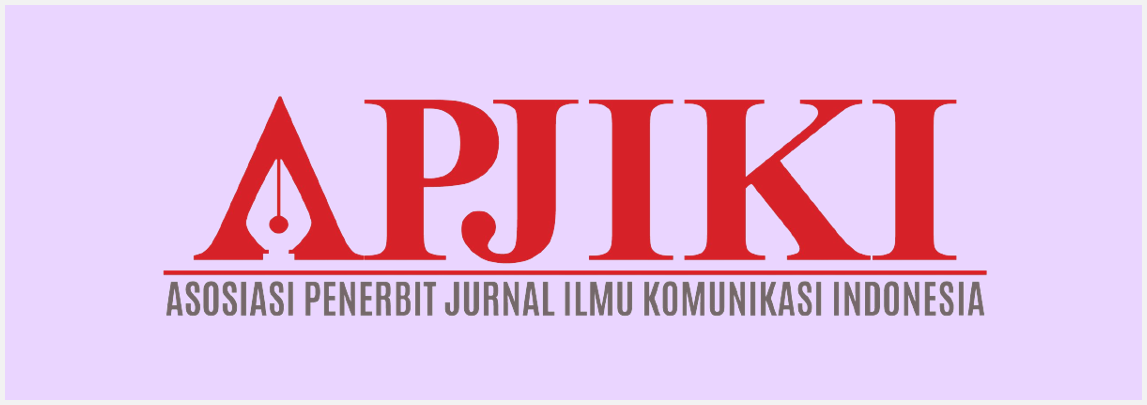Penggunaan Attribution Theory Pada Penanganan Komplain Nasabah Melalui Instagram @bankbri_id Oleh Customer Service Digital
Abstract
There are several complaints comments on Instagram Bank Rakyat Indonesia @bankbri_id that customers write. This research focuses on the use of Attribution Theory that is used in the process of resolving complaint. The fact that underlies this research is that customers are dissatisfied with the services provided by the company. Complaint-related comments on the company's social media must be resolved immediately in order to maintain the quality of service and the company's reputation. This research uses a qualitative approach with the netnographic method, which is a method used to for examining the communication which originates in new technologies and is carried out by individuals. The results showed that the use of Internal Attributes by Bank Rakyat Indonesia's Digital Customer Service to customers who have the potential to produce viral negative comments and External Attributes are used on customers who have recently complained and often complain but their viral potential is relatively small. This research could be used as a reference for companies, especially those that have a digital customer service division.
Keywords: Complaints, Digital Services, Attribution
Abstrak
Pada Instagram Bank Rakyat Indonesia yaitu @bankbri_id terdapat beberapa komentar komplain yang nasabah tuliskan. Penelitian ini fokusnya pada penggunaan Attribution Theory yang digunakan pada proses penyelesaian komplain. Fakta yang mendasari penelitian ini adalah pelanggan merasa tidak puas dengan pelayanan yang diberikan oleh perusahaan. Komentar komplain yang ada pada media sosial perusahaan harus segera diselesaikan untuk menjaga kualitas pelayanan dan reputasi perusahaan. Penelitian ini menggunakan pendekatan kualitatif dengan metode netnografi yaitu metode yang digunakan untuk meneliti komunikasi yang dilakukan oleh individu secara digital yaitu melalui media sosial. Hasil penelitian menunjukkan bahwa Customer Service Digital Bank Rakyat Indonesia menggunakan Atribut Internal dalam menghadapi nasabah yang berpotensi menghasilkan komentar negatif serta viral di Instagram @bankbri_id dan menerapkan Atribut Eksternal pada nasabah yang baru pertama kali melakukan komplain dan nasabah yang sudah sering komplain, tetapi potensi viralnya relatif kecil. Penelitian ini dapat menjadi referensi bagi perusahaan khususnya yang mempunyai divisi layanan pelanggan secara digital.
Kata Kunci : Komplain, Layanan Digital, Atribusi
Keywords
Full Text:
PDF (Bahasa Indonesia)References
Ardianto, E. (2010). Metodologi Penelitian untuk Public Relations. Bandung, Indonesia: Simbiosa Berkatama Media.
Arvan, M. L., Dreibelbis, R. C., & Spector, P. E. (2019). Customer Service Stress: A Meta-Analysis Of Customer Mistreatment. Research in Occupational Stress and Well-Being, 17, 117-136.
Bank Rakyat Indonesia [@bankbri_id]. instagram.com. [Diakses Mei 2020]
Caruso, D. R., & Salovey, P. (2004). The Emotionally Intelligent Manager. San Fransisco, CA: Jossey-Bass.
Chakraborty, U. (2019). The impact of source credible online reviews on purchase intention. Journal of Research in Interactive Marketing, 13(2), 142-161.
Chiou, W. B. (2007). Customers' Attributional Judgements Towards Complain Handling in Airline Service: A Confirmatory Study Based on Attribution Theory. Psychological Reports, 100, 1141-1150.
Elena, C. A. (2016). Social Media–a Strategy in Developing Customer Relationship Management. Procedia Economics and Finance, 39, 785-790.
Evenson, R. (2011). Customer service training 101: Quick and easy techniques that get great results (2nd ed.). New York, NY: American Management Association.
Garcia, P. J., Restubog, S. D., Lu, V. N., Amarnani, R. K., Wang, L., & Capezio, A. (2019). Attributions of blame for customer mistreatment: Implications for employees’ service performance and customers’ negative word of mouth. Journal of Vocational Behavior, 203-213.
Goussinsky, R. (2011). Customer aggression, emotional dissonance and employees’ well-being. International Journal of Quality and Service Sciences, 3(3), 248-266.
Kasmir, D. (2017). Customer Service Excellent. Depok: Raja Grafindo Persada.
Kozinets, R. V. (2015). Netnography: Redefined. Los Angeles, CA: Sage Publications Inc.
Kriyantono, R. (2014). Teori-Teori Public Relations Perspeftif Barat & Lokal: Aplikasi Penelitian dan Praktik. Jakarta: Kencana.
Ladhari, R., Ladhari, I., & Morales, M. (2010). Bank service quality: comparing Canadian and Tunisian customer perceptions. International Journal of Bank Marketing, 29(3), 244-246.
Littlejohn, S. W., & Foss, K. A. (2009). Encyclopedia of Communication Theory (Ninth Edition). United States of America: SAGE Publications.
Littlejohn, S. W., Foss, K. A., & Oetzel, J. G. (2017). Theories of Human Communication (Eleventh Edition). Illinois, IL: Waveland Press, Inc.
Lumbantobing, V. M. (2015). Peranan Komunikasi Customer Service Terhadap Kepuasan Pelanggan Lintas Semesta Surabaya. Jurnal Komunikasi, IX (1), 13-20.
Medler-Liraz, H. (2020). Customer incivility, rapport and tipping: the moderating role of agreeableness. Journal of Service Marketing. 955-966.
Nwogwugwu, D. I. (2017). Effective Customer Relations as a Public Relations Strategy in Financial Institutions A. Study of Access Bank Plc Ibadan, Oyo State, Nigeria. International Journal of Communication, 16-29.
Perloff, R. M. (2017). The Dynamics of Persuasion Communication and Attitudes in the 21st Century. New York, NY: Routledge Taylor & Francis Group.
Poddar, A., & Madupalli, R. (2012). Problematic customers and turnover intentions of customer service employees. Journal of Services Marketing, 26(7), 551-559.
Rangkuti, F. (2017). Customer Care Excellence. Jakarta: PT Gramedia Pustaka Utama.
Rusydi, M. (2017). Customer Excellence. Yogyakarta: Gosyen Publishing.
Safko, L. (2012). The Social Media Bible. New Jersey, Canada: John Wiley & Sons, Inc., Hoboken.
Shankman, P. (2011). Customer Service New Rules for a Social Media World. Indianapolis, I: Pearson Education.
Sommovigo, V., Setti, I., Argentero, P., & O’Shea, D. (2018). The impact of customer incivility and verbal aggression on service providers: A systematic review. Work, 1-28.
Sommovigo, V., Setti, I., O’ Sheab, D., & Argenteroa, P. (2020). Investigating employees’ emotional and cognitive reactions to customer mistreatment: an experimental study. European Journal of Work and Organizational Psychology, 1-21.
Spector, R., & McCarthy, P. (2012). The Nordstrom Way to Customer Service Excellent. New Jersey, Canada: John Wiley & Sons, Inc., Hoboken.
Walker, L. H. (2019). The effect of consumer emotions on outcome behaviors following service failure. Journal of Services Marketing, 33(3), 285-302.
Waroquiera, L., Abadie, M., & Dienes, Z. (2020). Distinguishing the role of conscious and unconscious knowledge in evaluative conditioning. 1-12.
Zamani, E. D., Giaglis, G. M., & Kasimati, A. E. (2015). Public Relations Crisis and Social Media: An Investigation into Extant and Prospective Consumers' Perceptions through the Lens of Attribution Theory. Journal of Theoretical and Applied Electronic Commerce Research, 10(2), 33-52.
DOI: https://doi.org/10.36914/jikb.v7i1.603
Refbacks
- There are currently no refbacks.
Copyright (c) 2021 Jurnal Ilmu Komunikasi dan Bisnis
Publisher: Sekolah Tinggi Ilmu Komunikasi dan Sekretari Tarakanita Copyright








